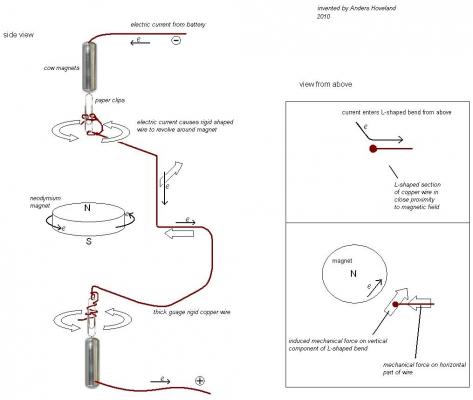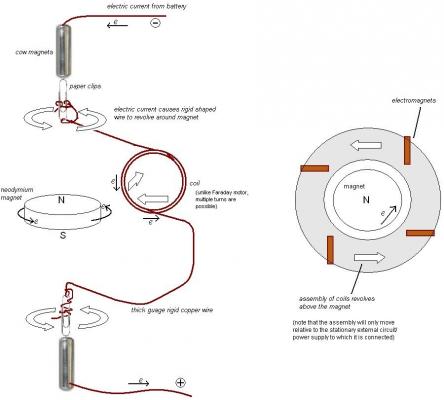

Anders Hoveland
Senior Members-
Posts
171 -
Joined
-
Last visited
Profile Information
-
Favorite Area of Science
unusual oxidizer chemistry
Recent Profile Visitors
The recent visitors block is disabled and is not being shown to other users.
Anders Hoveland's Achievements

Baryon (4/13)
-73
Reputation
-

Questioning Abortion as an advance towards freedom
Anders Hoveland replied to Anders Hoveland's topic in Politics
http://www.youtube.com/watch?v=WmytgRQ7hEY&feature=player_embedded- 134 replies
-
-1
-
The germans are not happy about their incandescent bulbs being taken away:
-

Are high efficiency indandescent lights possible?
Anders Hoveland replied to Anders Hoveland's topic in Quantum Theory
This is actually possible. I have a book on non-linear optics. Frequency doubling is possible with high efficiencies (>50%). Normally this uses dichroic filters, so I am not sure how this would work with broad range frequencies. A common green laser pointer is an example of this. The basic principle of frequency doubling is not really (very) complicated. In any optics system there will theoretically be some second harmonic generation, although normally this is negligable. However, by amplifying the desired second harmonic and suppressing the original frequency, conversion is possible. To preemptively answer your question, two photons do indeed condense into one, which is not that complicated to understand since the photons are already coupled with the transmitting medium. Indeed, transmittance is actually just absorbance over multiple dipoles (where the wavefuction has not collapsed) and synchronised emittance. (that is why light travels more slowly through glass) For practical frequency doubling devices, it is almost always a mutliple pass optical system. If such a lamp were possible, presumably just the filament unit would be replaceable, while the more expensive optics would be a permanent fixture. Now to go off on a random tangent... spontaneous frequency doubling in a vacuum is not possible because of photon spin conservation, but spontaneous frequency tripling is... (although so negligible it cannot be detected) -
Something else to consider is hydrocarbons, which are relatively chemically inert, similar to fluorocarbons.
-

Questioning Abortion as an advance towards freedom
Anders Hoveland replied to Anders Hoveland's topic in Politics
If Obama was pro-life he would be very convincing. That was an excellent speech. I wonder if he realises the dark irony of what he read.- 134 replies
-
-2
-

Are high efficiency indandescent lights possible?
Anders Hoveland replied to Anders Hoveland's topic in Quantum Theory
What about candoluminescence ? Like the thorium mantle used in camping laterns? Could tungsten filaments coated with a thorium and cerium oxide coating to increase their efficiency? Could coating the tungsten filament with a thorium dioxide coating prevent evaportation of the tungsten? Since thorium dioxide is a ceramic, it is not vulnerable to evaporation at high temperatures close to its melting point. With the photonic crystal filaments, would it not be impossible to somehow fill the tungsten lattice structure with translucent thorium dioxide ceramic to prevent evaporation and degredation of the vulnerable fine structure? I found this, that some of you may find interesting: http://www.lamptech.co.uk/Spec%20Sheets/IN%20WC%20DuroTest%20120-65G30IRC-E26.htm -

quantum leap to path of least resistance?
Anders Hoveland replied to 36grit's topic in Quantum Theory
Quantum physics understands the mathematics that desribe the predicted behavior, they just do not know the underlying cause, if there even is a cause, or whether it is just an inherent law of nature. -
Helium is the only noble gas that does not have 8 electrons in its outer shell. And hydrogen does form a metal-like state under extremely high pressure. An argument certainly can be made that hydrogen has chemistry in common with both halogens and alkali metals. But really, hydrogen is its own unique group. This is one of the problems when you try to classify different unique sets of properties into defined groups. The periodic table is like racism against chemical elements.
-

Is the photon carrier more important than photon?
Anders Hoveland replied to alpha2cen's topic in Physics
I am of the opinion that the medium through which photons travel is a type of electromagnetic energy itself, composed of long wavelength photons in a state of flux and equilibrium. This energy behaves as "virtual" energy because self-interference prevents it from permanently imparting energy. The carrier is referred to as "vacuum energy", and has a far higher energy density than matter. My view is that in the absence of a medium, a photon would travel infinitely fast, or from a different perspective variations in density of the vacuum energy would be like curved space. In the absence of vacuum energy, the entire universe would be much smaller. -
- 9 replies
-
-1
-
No, actually a permanent magnet does give off real photons. They are extremely long wavelength, and it is dependant on the movement of the magnet. If you moved a bar magnet yesterday, and plan to move it back to its original position tomorrow, it is currently in the process of emitting real photons, at least theoretically. Normally these photons will almost entirely be "virtual", it is only when there is an actual interaction with the magnetic field that they will become "real". It may be difficult to conceptualise, but these photons are fundamentally no different than any other photons.
-
I had this idea for a new type of electric motor. (see diagrams in attachments) I have not actually built a working prototype. Would it work? Or specifically what I am asking is this: I know that the current flowing towards the magnet can result in a perpendicular force. Is it possible for current to flow away from the magnet (as indicated in the diagram) without inducing an equal and opposite perpendicular force? The new type of homopolar electric motor is similar in principle to the faraday motor. Unlike the faraday motor, however, this new design can easily be adapted to utilize multiple turns in the wire; in other words it can use coils of wire, rather than only a single wire. This motor has the advantage of running on simple direct current, without the need for any sort of commutators, either internal or external. In addition, the design does not require any conventional brushes. Pivotal electric contact points are still required however, but these have some advantages over brushes. Conventional electric motors cannot be designed to only use pivotal contact points without problems of the coil frequently getting locked up, caused by normal variation in the mechanical load. It should also be noted that even if the wire is held in place, with the magnet allowed the freedom to spin, there will not be any circular motion induced on the magnet. This seeming asymetry can be explained by the fact that the circular motion induced on the copper wire is relative to the external circuit (which is away from the magnetic field), not the magnet. Also note that the critical L-shaped section of wire must be on one of the polar sides of the magnet, and the wire must be diagonal to the magnetic axis. Simply having a toroidal coil which surrounds the magnet will not cause any induced circular motion in the coil, because the winds would be aligned with the magnetic axis. The copper wire must be rigid enough to maintain its shape. The only freedom of motion allowed to the L-shaped section should be mobility around the magnetic axis, while maintaining its relative distance and alignment with respect to the magnetic field. Unfortunately, this motor design cannot work in reverse as an electric generator. Obviously, the more practical application of this design is that it can allow the faraday motor to utilize multiple turns in a coil, an therfore gain the required efficiency to become practical for commercial operation. In the well known Faraday motor, one of the contact points must be around the radius of the magnet, otherwise a straight wire will be subject to opposing mechanical forces, as the wire tries to flip to be perpendicular to the magnetic axis. If the wire segment is constrained, only free to revolve around the magnetic axis, there would then be no induced motion, as the opposing mechanical forces in opposition are equal in magnitude, and the vectors (at any given instant) are parallel to eachother and the allowed mechanical motion. For the Faraday design to utilize a coil would require countless contact points, making such a potential design both impractically complex and unreliable in actual operation. The Faraday motor is only a demonstration of electromagnetic principles, with absolutely no practical application. Simply thinking only in terms of "magnetic poles" is not adequate to understand the operation of either this design or the Faraday motor demonstration.
-
These organic semiconductor polymer strips could eventually replace fluorescent lighting. They have a much better quality of light, and are comparable in efficiency to current LEDs. They contain multi-walled carbon nanotubes and operate best on 80 kHz frequency current. http://www.gizmag.com/fipel-alternative-fluorescent-lights/25287/ http://www.sciencedirect.com/science/article/pii/S1566119912004831
-

Are high efficiency indandescent lights possible?
Anders Hoveland replied to Anders Hoveland's topic in Quantum Theory
I was thinking about the idea of using molten tungsten as the incandescent source, contained within some translucent ceramic. Thorium dioxide is a translucent white ceramic with a melting point of 3390 C (3663 K). Tantalum nitride is a dark brown colored ceramic with which melts at approximately 3360 C. It is insoluble in water. Unfortunately nothing seems to quite match tungsten's 3422 C melting point. or perhaps someting like the Nernst lamp. If the filament was immersed in a molten ceramic, it would probably prevent evaporation of the filament so that it could me operated much closer to its melting point. -
But there is not much point in switching if the evenings are cold most of the year. The CFLs can give off UV, which may be undesirable in many situations, and (most) CFLs give off an inferior quality of light. Again, the better quality of light, the more expensive it is. This misguided notion that everyone switching to CFLs will reduce energy consumption is based on a number of false assumptions. The big 3 light bulb manufacturers were the ones pushing this, and all the gulible environmentalists jumped on board without asking questions. There are quite a number of common situations where switching to CFL bulbs will result in more energy consumption, not less. An efficiency mandate was a terrible ill-thought out idea. But then again it was drafted to increase profits, not save the environment. The light bulb manufacturers essentially drafted the legislation. GE spent more money on political lobbying than they paid in taxes. They are trying to go after China and Mexico because that is where all of these less expensive incandescent bulbs are made.The real secret to the light bulb phaseout is government sanctioned monopolies. Guess who holds the patents on LED technology? Yes, there are a number of very small companies (with limited research budgets) but none of them will be able to ramp up production anywhere near what the big 3 will.GE, Phillips, and Osram Sylvania stand to make enormous profits once they have succeeded in getting the government to take consumer's other options off the table.


